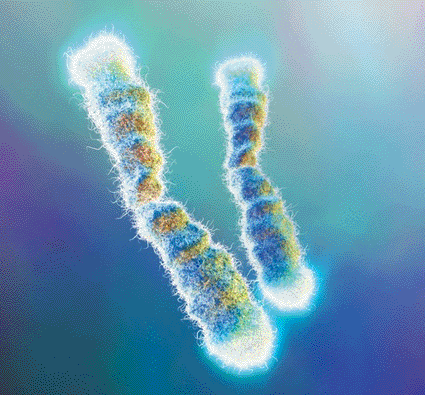Heat Combined with Radiation Makes Tumor Cells Easier to Destroy
By MedImaging staff writers
Posted on 27 May 2008
Posted on 27 May 2008

Image: Computer artwork of two chromosomes highlighted where the telomeres are located (Photo courtesy of Hybrid Medical Animation).
By interfering with that protection, researchers from Washington University School of Medicine in St. Louis (MO, USA) have shown that tumor cells grown in culture can be made more sensitive to hyperthermia-enhanced radiation therapy.
Radiation therapy is a mainstay of cancer treatment but does not always totally control tumors. For several years, raising tumor temperature has been investigated as a radiation therapy enhancer with few adverse side effects. "Past research has shown that hyperthermia is one of the most potent ways to increase cell-killing by radiation,” said senior author Tej K. Pandita, Ph.D., associate professor of radiation oncology and of genetics and a researcher with the Siteman Cancer Center at Washington University School of Medicine and Barnes-Jewish Hospital. "But now we've found that heat also enhances the activity of an enzyme called telomerase in cancer cells. Telomerase helps protect the cells from stress-induced damage and allows some of them to survive. We used compounds that inhibit telomerase and showed that cancer cells then become easier to destroy with hyperthermia and radiation used in combination.”
Telomerase repairs the ends of chromosomes by maintaining stability of specialized cellular structures called telomeres after cells divide. Without telomerase, the number of cell divisions is limited. Telomerase is not active in most normal human cells but is active in most cancer cells, which rely on telomerase to continue to proliferate.
In this study, Dr. Pandita's research group found that moderately increasing the heat also increases the activity of telomerase in tumor cells. The researchers found that if they inactivated telomerase and then increased the temperature of tumor cells, more cells were killed by ionizing radiation. Because nearly all cancers have telomerase, drugs that inactivate its activity could be useful against many cancers.
The researchers evaluated three compounds, and one, GRN163L, more strongly suppressed telomerase than the others. Many groups are studying GRN163L as an anticancer therapeutic agent, and it recently received clearance by the U.S. Food and Drug Administration (FDA) to enter human phase I/II clinical testing in chronic lymphocytic leukemia patients. In some preliminary studies, GRN163L has been shown to be additive when used in combination with existing cancer drugs or radiation.
Next, Dr. Pandita and colleagues will assess the effect of GRN163L on tumors in mice to see if it will enhance the cell-killing effect of hyperthermia and radiation. They are also working to develop chemicals that have heat-like effects to bypass the need to supply a physical heat source to tissue.
The study was published in the May 1, 2008, issue of the journal Cancer Research.
Related Links:
Washington University School of Medicine in St. Louis














